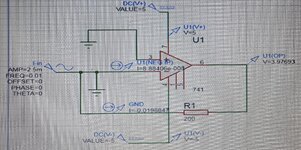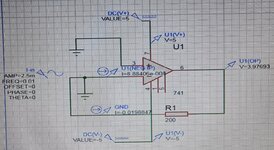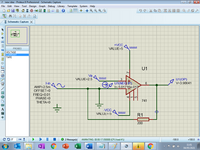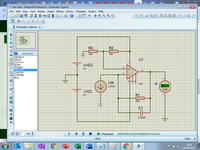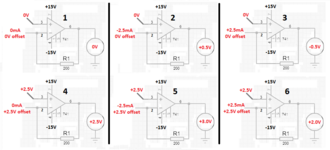gc627
Newbie
i know the basics of an op amp with just the negative and positive input and one output , using a resistor Rf it will stop the current flowing in to the inputs and instead convert it into a voltage at Vout
the supply is a ac current in the range of -2.5 to 2.5 mA with an frequency of 0.01 Hz and output is 2 to 3v
Rf = VoMax -VoMin /IinMax -IinMin = 3v - 2v / 0.0025A - -0.0025A = 200 ohms
so i know the 741 needs a supply voltage of up to 15 v to operate ,why does the supply voltage of pins 4 and 7 affect the output ?
ive looked all over for examples but the ones i see have just a positive and negative unknown value at pins , if anyone has any links explaining this it would be greatly appreciated
so one attempt is saying 3.97 v and even when i remove the ac source from the circuit and resimulate it doesn't change anything therefore it hasn't converting current to begin with ?
the supply is a ac current in the range of -2.5 to 2.5 mA with an frequency of 0.01 Hz and output is 2 to 3v
Rf = VoMax -VoMin /IinMax -IinMin = 3v - 2v / 0.0025A - -0.0025A = 200 ohms
so i know the 741 needs a supply voltage of up to 15 v to operate ,why does the supply voltage of pins 4 and 7 affect the output ?
ive looked all over for examples but the ones i see have just a positive and negative unknown value at pins , if anyone has any links explaining this it would be greatly appreciated
so one attempt is saying 3.97 v and even when i remove the ac source from the circuit and resimulate it doesn't change anything therefore it hasn't converting current to begin with ?
Attachments
Last edited:
